Hydrangeas are known as a gardener’s delight, known for their healthy, full blooms and a wide spectrum of colours that can transform any garden into a vibrant harbour. These plants are native to Asia and the Americas, thrive in temperate climates, and come in various species, each offering unique flower shapes and growth habits. From the classic mophead hydrangeas with their globe-like blooms to the elegant lacecap varieties, hydrangeas provide visual interest throughout the growing season. Their ability to change colour based on soil pH adds an element of surprise and customization to your garden palette.
In this guide, we will explore everything you need to know about How to Grow Hydrangeas, from selecting the right varieties and planting techniques to ongoing care and troubleshooting common issues. Whether you’re a starter or an experienced gardening enthusiast, these tips and insights will help you cultivate stunning hydrangeas that will increase your garden’s beauty year after year.
How to Grow Hydrangeas
What Are Hydrangeas?
Hydrangeas are flowering plants that belong to the genus Hydrangea, which includes around 70-75 species. They are native to Asia and the Americas, thriving in temperate climates. Hydrangeas are known for their large, showy flower heads. These flowers come in various colours, including white, blue, pink, and purple, often changing shades based on soil pH levels.
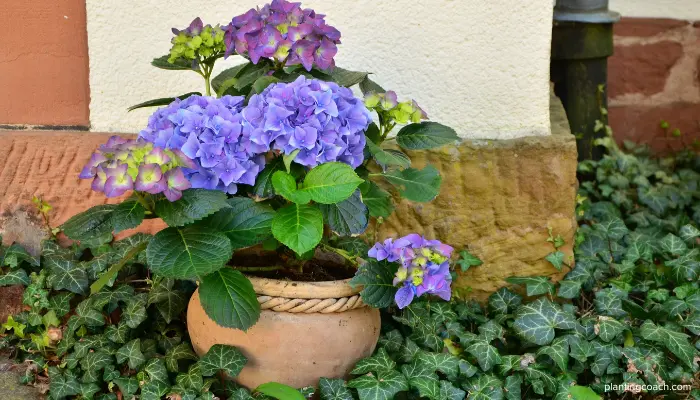
Historically, hydrangeas have been cultivated for centuries, with significant cultural importance in countries like Japan, where they symbolize gratitude and apology. In Western cultures, hydrangeas are often associated with heartfelt emotions and are popular choices for ornamental gardening and floral arrangements.
Types of Hydrangeas
There are several types of hydrangeas, each with unique characteristics and growing requirements:
Mophead Hydrangeas (Hydrangea macrophylla): Known for their large, rounded flower heads, these hydrangeas are the most common and come in various colours. They thrive in partial shade and require well-drained soil.
Lacecap Hydrangeas (Hydrangea macrophylla normalis): These have a similar structure to mopheads but feature flat flower heads with a centre of tiny, fertile flowers surrounded by larger, sterile blooms. They prefer partial shade and moist, well-drained soil.
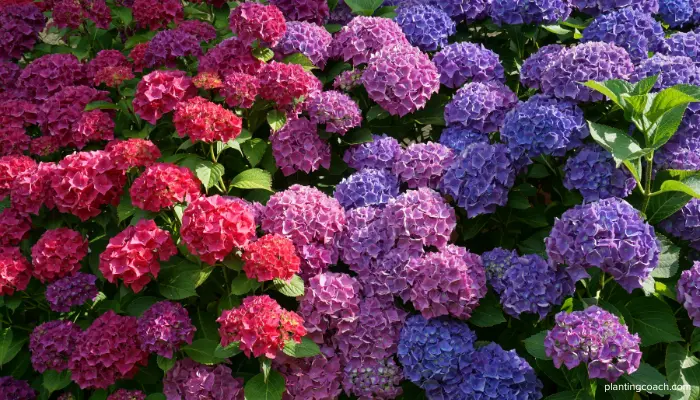
Panicle Hydrangeas (Hydrangea paniculata): These hydrangeas have cone-shaped flower heads and are more tolerant of sun and heat than other types. They can grow quite large and are hardy in colder climates.
Smooth Hydrangeas (Hydrangea arborescens): Known for their resilience, smooth hydrangeas produce large, round flower heads and thrive in various conditions, including partial shade and full sun.
Oakleaf Hydrangeas (Hydrangea quercifolia): Recognizable by their oak-shaped leaves, these hydrangeas offer stunning fall foliage and cone-shaped flower clusters. They prefer well-drained soil and partial shade.
Best Hydrangeas to Grow
Choosing the right hydrangea variety depends on your climate, soil, and garden design goals. Here are some top recommendations:
For cooler climates: Panicle hydrangeas like ‘Limelight’ and ‘Quick Fire’ are excellent choices due to their hardiness.
For warmer climates: Smooth hydrangeas such as ‘Annabelle’ and ‘Incrediball’ thrive well in warmer temperatures.
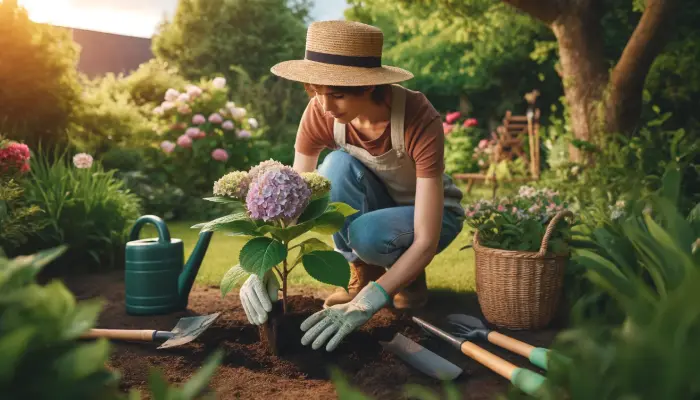
For vibrant colours: Mophead hydrangeas like ‘Endless Summer’ and ‘Nikko Blue’ offer stunning blue and pink blooms, depending on soil pH.
Always consider your garden’s specific conditions and desired elegance when selecting the best hydrangeas to grow.
When and Where to Plant Hydrangeas
Timing and location are crucial for successful hydrangea growth. Here’s what you need to know before planting these:
Planting Time: The best time to plant hydrangeas is in the spring or fall when temperatures are mild. This allows the plants to establish roots before the extremes of summer heat or winter cold.
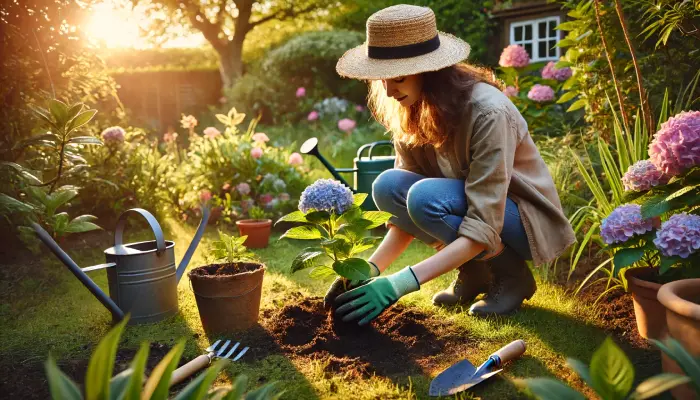
Location: Choose a spot that receives morning sun and afternoon shade, especially for mophead and lacecap varieties. Panicle hydrangeas can tolerate more sun, while oakleaf and smooth hydrangeas prefer partial shade.
Soil: Ensure the planting area has well-drained soil enriched with organic matter. Avoid areas prone to waterlogging, as hydrangeas do not thrive in overly wet conditions.
Best Soil for Hydrangeas
The right soil can make a significant difference in the health and bloom quality of hydrangeas:
Soil pH: Hydrangeas are unique because their flower colour can change based on soil pH. For blue flowers, aim for acidic soil (pH 5.2-5.5). For pink flowers, neutral to slightly alkaline soil (pH 6.0-6.2) is ideal. You can adjust soil pH using soil amendments like sulfur or lime.
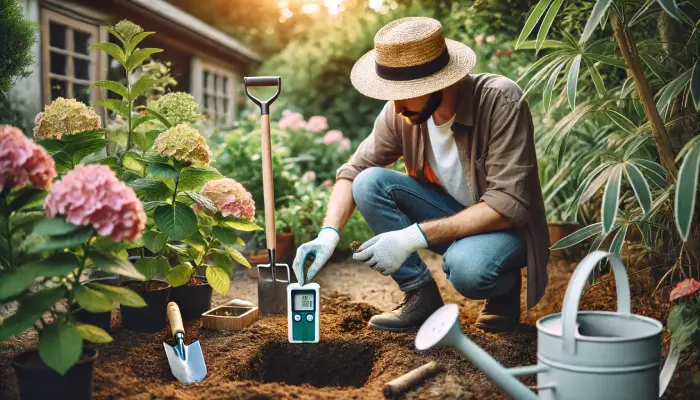
Soil Composition: Hydrangeas prefer loamy or moist soil rich in organic matter. This type of soil retains moisture well while providing adequate drainage.
Improving Soil Quality: Incorporate compost or well-rotted manure into the soil before planting. This improves the soil’s structure and enriches it with nutrients.
How to Care for Hydrangeas
Caring for hydrangeas involves regular maintenance and attention to their specific needs. Here are some essential hydrangea care tips that you need to follow:
Watering: Hydrangeas need consistent moisture, especially during their first year after planting. Water deeply once or twice a week, ensuring the soil is moist but not waterlogged. During hot, dry periods, increase watering frequency.
Fertilizing: Feed hydrangeas with a balanced, slow-release fertilizer in spring and mid-summer. Avoid over-fertilizing, as this can lead to rich foliage and abundant blooms.
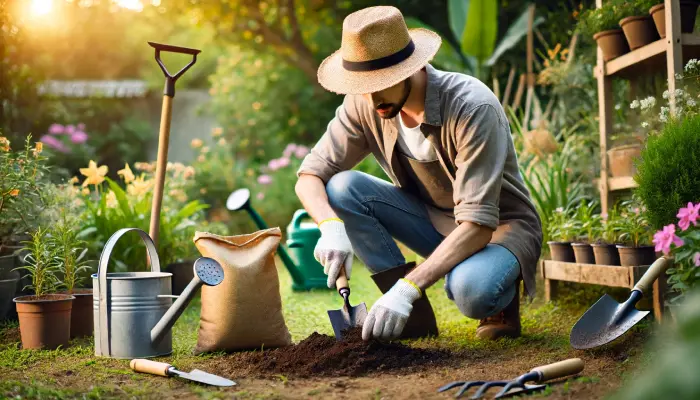
Mulching: Apply a layer of mulch around the base of the plants to conserve moisture, regulate soil temperature, and prevent weeds. Organic mulches like pine bark or straw are excellent choices.
Pruning: Proper pruning is essential for maintaining the health and shape of hydrangeas. The timing and method of pruning depend on the type of hydrangea you’re dealing with.
Pest and Disease Control: Keep an eye out for common pests like aphids, spider mites, and scale. Use insecticidal soap or neem oil for treatment. Prevent diseases such as powdery mildew and root rot by ensuring good air circulation and proper watering practices.
Winter Protection: In colder climates, protect hydrangeas from harsh winter conditions by covering them with burlap or applying a thick layer of mulch around the base.
How to Prune Hydrangeas Properly
Pruning is a crucial part of hydrangea care, promoting healthy growth and abundant blooms:
Types:
Different types of hydrangea plants require different methods of pruning, such as:
Mophead and Lacecap Hydrangeas: Prune after flowering, cutting back to just above a pair of healthy buds. Remove dead or weak stems.
Panicle Hydrangeas: Prune in late winter or early spring before new growth begins. Cut back to a pair of healthy buds or reduce the plant by one-third.
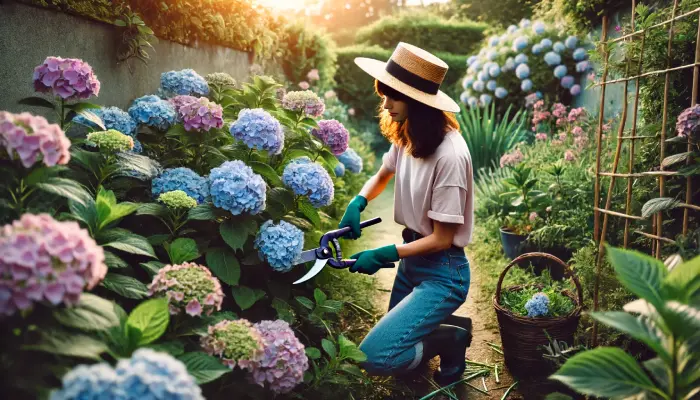
Smooth Hydrangeas: Prune in late winter or early spring. Cut back stems to about 12 inches from the ground to encourage strong, new growth.
Oakleaf Hydrangeas: Prune after flowering, removing dead or damaged wood and thinning out overcrowded branches.
Timing:
The best time to prune hydrangeas depends on their type. Mophead and lacecap hydrangeas should be pruned immediately after flowering, while panicle and smooth hydrangeas benefit from late winter or early spring pruning.
Techniques:
Use clean, sharp pruning shears to make clean cuts. For mophead and lacecap hydrangeas, cut back to just above a pair of healthy buds. Panicle hydrangeas can be cut back more aggressively, reducing the plant by about one-third. Smooth hydrangeas should be pruned to about 12 inches from the ground to encourage vigorous new growth.
Tools:
Invest in high-quality pruning shears, loppers for thicker branches, and gloves to protect your hands.
How to Propagate Hydrangeas
Propagating hydrangeas allows you to expand your garden or share plants with friends. There are some recognized and popular methods a gardener should have in mind while thinking of propagating hydrangeas, such as:
Cuttings: Take softwood cuttings in late spring or early summer. Dip the cut end in rooting hormone and plant in a mix of sand and perlite. Keep the soil moist and place the cutting in a bright, indirect light location.

Layering: Select a low-growing branch and gently bend it to the ground. Make a small wound on the underside of the branch and cover it with soil, exposing the tip. Secure with a stone or pin. After the roots develop, cut the new plant from the parent and transplant it.
Division: For hydrangeas that form clumps, such as smooth and oakleaf varieties, divide the plant in early spring or fall. Dig up the entire plant and carefully separate the root ball into sections, each with at least one healthy stem and root system. Replant each section immediately.
Common Problems Relating to Hydrangeas and Solutions
Even with the best care, hydrangeas can encounter problems. Here are some common issues and solutions:
Yellowing Leaves: Often caused by poor drainage or overwatering. Ensure soil is well-drained and adjust watering practices.
Wilting: Can result from underwatering, overwatering, or transplant shock. Check soil moisture levels and adjust watering accordingly.
Powdery Mildew: This fungal disease appears as a white powdery coating on leaves. Improve air circulation, avoid overhead watering, and use a fungicide if necessary.

Pests: Aphids, spider mites, and scale can infest hydrangeas. Use insecticidal soap or neem oil to control these pests.
Lack of Blooms: This can be due to improper pruning, insufficient sunlight, or over-fertilization. Ensure proper pruning timing, provide adequate light, and avoid excessive nitrogen fertilizers.
Summary
Growing hydrangeas is a rewarding experience that can add vibrant colours and lush foliage to any garden. By understanding the different types of hydrangeas, selecting the best varieties for your climate, and planting them in the right location with suitable soil, you can set the foundation for healthy growth. Regular care, including proper watering, fertilizing, and pruning, ensures your hydrangeas thrive and produce beautiful blooms. Addressing common problems and propagating new plants further promotes your gardening success. With these comprehensive tips and guidelines, you’ll be well-equipped to enjoy the stunning beauty of hydrangeas in your garden year after year.
FAQ
Q1: Can you grow hydrangeas from cuttings?
Yes, hydrangeas can be grown from cuttings. Take softwood cuttings in late spring or early summer, dip the cut end in rooting hormone, and plant it in a mix of sand and perlite. Keep the soil moist and place the cutting in a bright, indirect light location until roots develop.
Q2: Do hydrangeas like sun or shade?
Hydrangeas typically prefer morning sun and afternoon shade. However, the specific light requirements can vary by type. For instance, panicle hydrangeas can tolerate more sun, while mophead and lacecap hydrangeas thrive in partial shade.
Q3: What month is best to plant hydrangeas?
The best time to plant hydrangeas is in the spring or fall when temperatures are mild. This allows the plants to establish roots before the heat of summer or the cold of winter.
Q4: Do hydrangeas smell?
Most hydrangeas do not have a strong fragrance. However, some varieties, like the climbing hydrangea (Hydrangea anomala subsp. petiolaris), have a light, pleasant scent when in bloom.
Q5: Does boiling water help hydrangeas?
Boiling water is not recommended for hydrangeas as it can damage the plant tissues. However, for cut hydrangea flowers, dipping the stems in boiling water for a few seconds can help extend their vase life by clearing any blockages and allowing better water uptake.
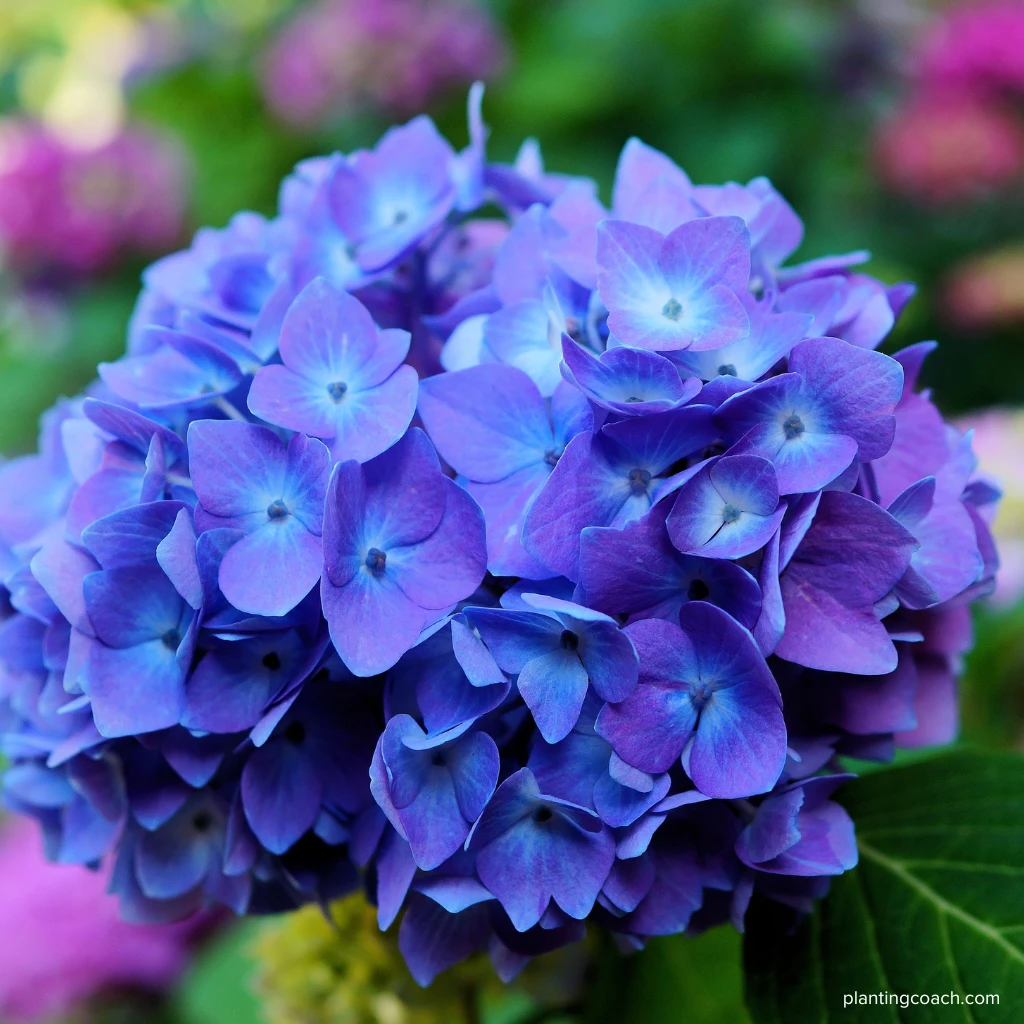

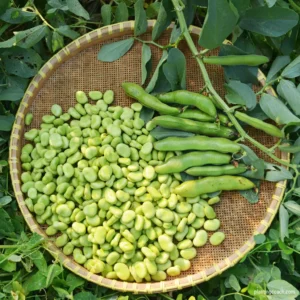
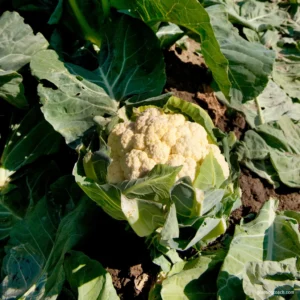
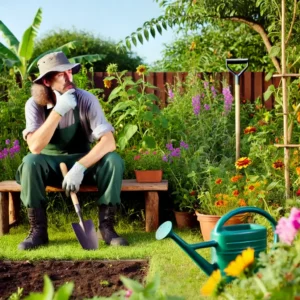

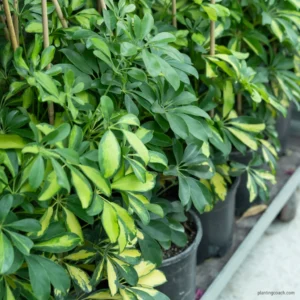

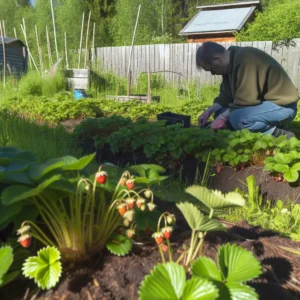
1 thought on “How to Grow Hydrangeas: A Comprehensive Guide”